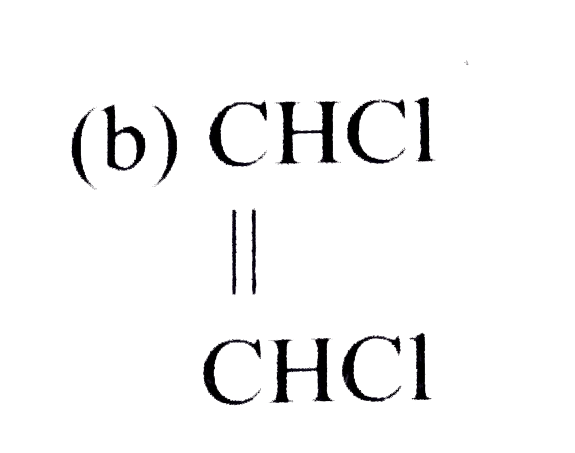Which of the following will be the final product when C2H2 reacts with HCl
CH∣∣CHCl
CH3∣CHCl2
CHCl∣∣CHCl
None of these
The correct Answer is:B
To determine the final product when acetylene (C₂H₂) reacts with hydrochloric acid (HCl), we can follow these steps:
Step 1: Identify the Reaction Type
Acetylene (C₂H₂) is an alkyne, and it undergoes electrophilic addition reactions. In this case, HCl acts as an electrophile.
Hint: Remember that alkynes typically react with electrophiles through addition reactions.
Step 2: Electrophilic Addition Mechanism
In the reaction, the hydrogen atom from HCl will add to one of the carbon atoms in the triple bond of C₂H₂, while the chloride ion (Cl⁻) will add to the other carbon atom.
Hint: Think about how the electrophile (H⁺) and nucleophile (Cl⁻) interact with the triple bond.
Step 3: Draw the Intermediate Product
When HCl adds to C₂H₂, it forms an intermediate product known as vinyl chloride (C₂H₃Cl). This compound has a double bond between the two carbon atoms and a chlorine atom attached to one of the carbons.
Hint: Visualize the structure of the intermediate product to understand where the atoms are added.
Step 4: Final Product Formation
If the reaction conditions allow for further addition, the vinyl chloride (C₂H₃Cl) can react with another molecule of HCl. This will lead to the saturation of the double bond, resulting in the formation of 1,1-dichloroethane (C₂H₄Cl₂).
Hint: Consider what happens if there is excess HCl present in the reaction.
Conclusion
The final product when C₂H₂ reacts with HCl is 1,1-dichloroethane (C₂H₄Cl₂) if the reaction goes to completion with excess HCl.
Final Answer: 1,1-dichloroethane (C₂H₄Cl₂)
Acetylene (C₂H₂) is an alkyne, and it undergoes electrophilic addition reactions. In this case, HCl acts as an electrophile.
In the reaction, the hydrogen atom from HCl will add to one of the carbon atoms in the triple bond of C₂H₂, while the chloride ion (Cl⁻) will add to the other carbon atom.
When HCl adds to C₂H₂, it forms an intermediate product known as vinyl chloride (C₂H₃Cl). This compound has a double bond between the two carbon atoms and a chlorine atom attached to one of the carbons.
If the reaction conditions allow for further addition, the vinyl chloride (C₂H₃Cl) can react with another molecule of HCl. This will lead to the saturation of the double bond, resulting in the formation of 1,1-dichloroethane (C₂H₄Cl₂).
The final product when C₂H₂ reacts with HCl is 1,1-dichloroethane (C₂H₄Cl₂) if the reaction goes to completion with excess HCl.
Topper's Solved these Questions
- HYDROCARBONBOOK - ERRORLESS CHAPTER - HYDROCARBONEXERCISE - ORDINARY THINKING (Objective question) (AROMATIC HYDROCARBON)
128 Videos
- HYDROCARBONBOOK - ERRORLESS CHAPTER - HYDROCARBONEXERCISE - CRITICAL THINKING (Objective questions)
24 Videos
- HYDROCARBONBOOK - ERRORLESS CHAPTER - HYDROCARBONEXERCISE - ORDINARY THINKING (Objective question) (ALKENE)
129 Videos
- HALOGEN CONTAINING COMPOUNDBOOK - ERRORLESS CHAPTER - HALOGEN CONTAINING COMPOUNDEXERCISE - Critical Thinking (Jee (Advanced) 2018)
1 Videos
- IONIC EQUILIBRIUMBOOK - ERRORLESS CHAPTER - IONIC EQUILIBRIUMEXERCISE - JS Jee Section (JEE Advanced (Numeric answer type question))
1 Videos
Similar Questions
Knowledge Check
Which of the following will be the final product when C20H2 reacts with HCl ?
A B
B C
C DNone of these
DNone of theseWhich of the following would be produced when acetylene reacts with HCl ?
ACH3CH2ClBCH3CHCl2CCH(Cl) = CH(Cl)DCH2=CH−ClWhich of the following would be produced when acetylene reacts with HCl
ACH3CH2ClBCH3CHCl2CCHCl=CHClDCH2=CHCl
Which of the following is not formed whenN2H4 reacts with H2SO4 to produce a series fasts?
View SolutionWhat are the products formed when H2 reacts with CuO?
View SolutionWhich of the following is formed when cadmium reacts with H2S?
View SolutionThe oxidation state of oxygen of H2O2 in the final products when it reacts with ClOɵ3 is
View SolutionFind the product formed when C2H2 reacts with Tollen's reagent
View Solution
